Self-Reflection on Communication Skills: Diagnostic Tools & Analysis
VerifiedAdded on 2023/06/11
|15
|4280
|378
Essay
AI Summary
This essay presents a self-reflection and analysis of interpersonal communication skills, focusing on public speaking anxiety and tolerance for disagreement. The analysis is based on five diagnostic tools: a Self-Perceived Communication Competence Questionnaire, a Personal Report of Communication Apprehension, a personal report related to public speaking, willingness to listen, and tolerance for disagreement. The author discusses personal experiences and scores from these tools, highlighting areas for improvement. The essay also includes a literature review of key communication concepts and theories, and concludes with an action plan for enhancing communication skills, including journaling for self-assessment. The author reflects on specific instances, such as managing anxiety before presentations and navigating disagreements in a professional setting, to illustrate the challenges and strategies for effective communication.
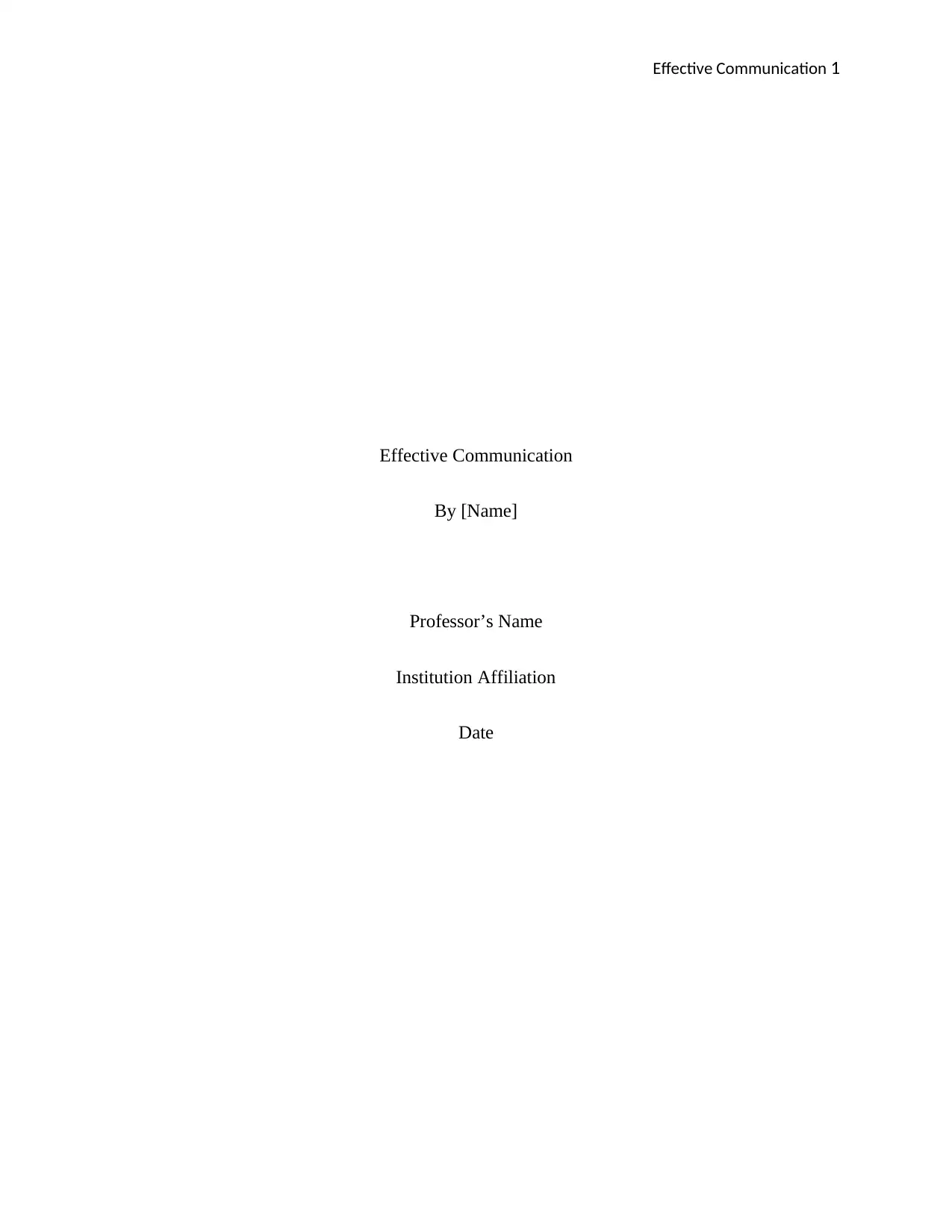
Effective Communication 1
Effective Communication
By [Name]
Professor’s Name
Institution Affiliation
Date
Effective Communication
By [Name]
Professor’s Name
Institution Affiliation
Date
Paraphrase This Document
Need a fresh take? Get an instant paraphrase of this document with our AI Paraphraser
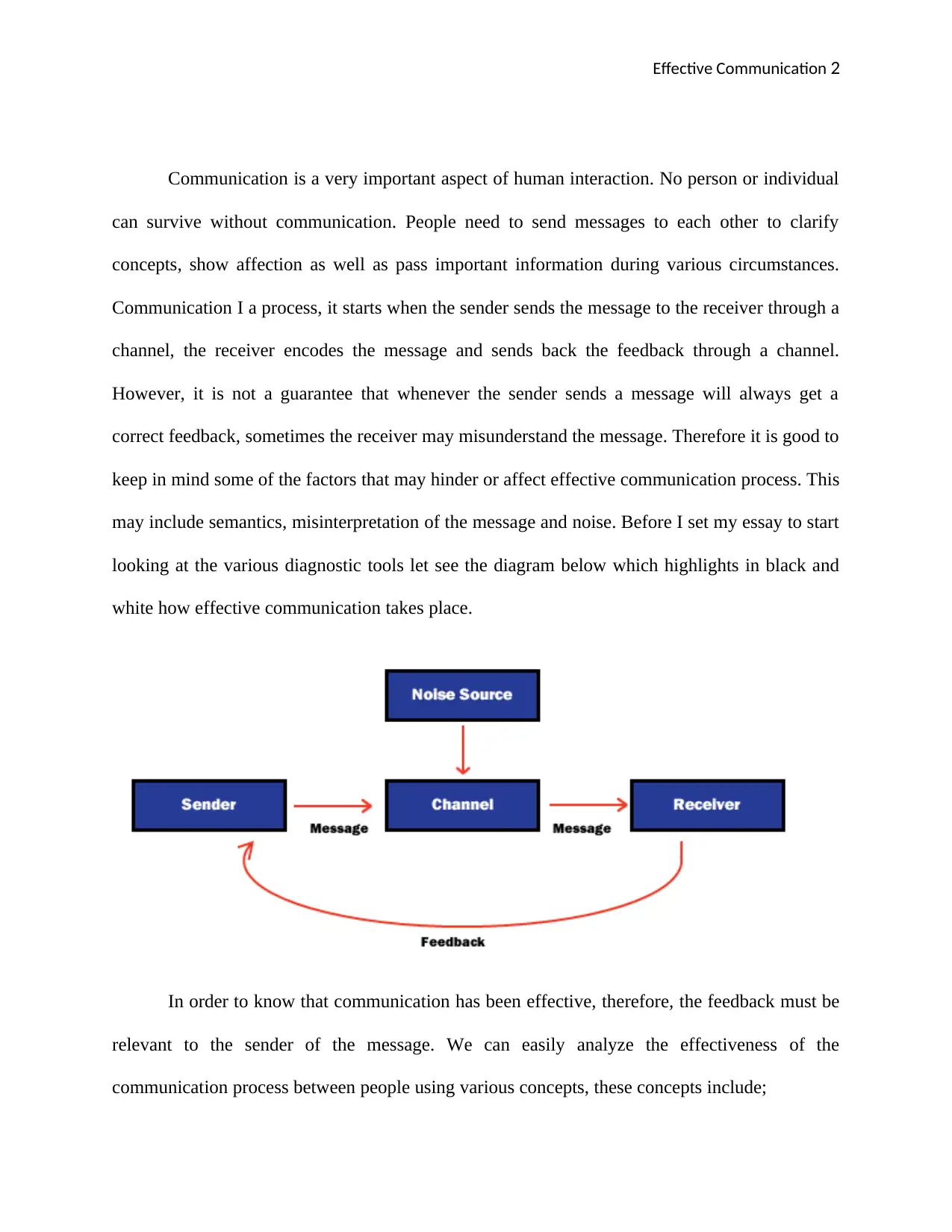
Effective Communication 2
Communication is a very important aspect of human interaction. No person or individual
can survive without communication. People need to send messages to each other to clarify
concepts, show affection as well as pass important information during various circumstances.
Communication I a process, it starts when the sender sends the message to the receiver through a
channel, the receiver encodes the message and sends back the feedback through a channel.
However, it is not a guarantee that whenever the sender sends a message will always get a
correct feedback, sometimes the receiver may misunderstand the message. Therefore it is good to
keep in mind some of the factors that may hinder or affect effective communication process. This
may include semantics, misinterpretation of the message and noise. Before I set my essay to start
looking at the various diagnostic tools let see the diagram below which highlights in black and
white how effective communication takes place.
In order to know that communication has been effective, therefore, the feedback must be
relevant to the sender of the message. We can easily analyze the effectiveness of the
communication process between people using various concepts, these concepts include;
Communication is a very important aspect of human interaction. No person or individual
can survive without communication. People need to send messages to each other to clarify
concepts, show affection as well as pass important information during various circumstances.
Communication I a process, it starts when the sender sends the message to the receiver through a
channel, the receiver encodes the message and sends back the feedback through a channel.
However, it is not a guarantee that whenever the sender sends a message will always get a
correct feedback, sometimes the receiver may misunderstand the message. Therefore it is good to
keep in mind some of the factors that may hinder or affect effective communication process. This
may include semantics, misinterpretation of the message and noise. Before I set my essay to start
looking at the various diagnostic tools let see the diagram below which highlights in black and
white how effective communication takes place.
In order to know that communication has been effective, therefore, the feedback must be
relevant to the sender of the message. We can easily analyze the effectiveness of the
communication process between people using various concepts, these concepts include;
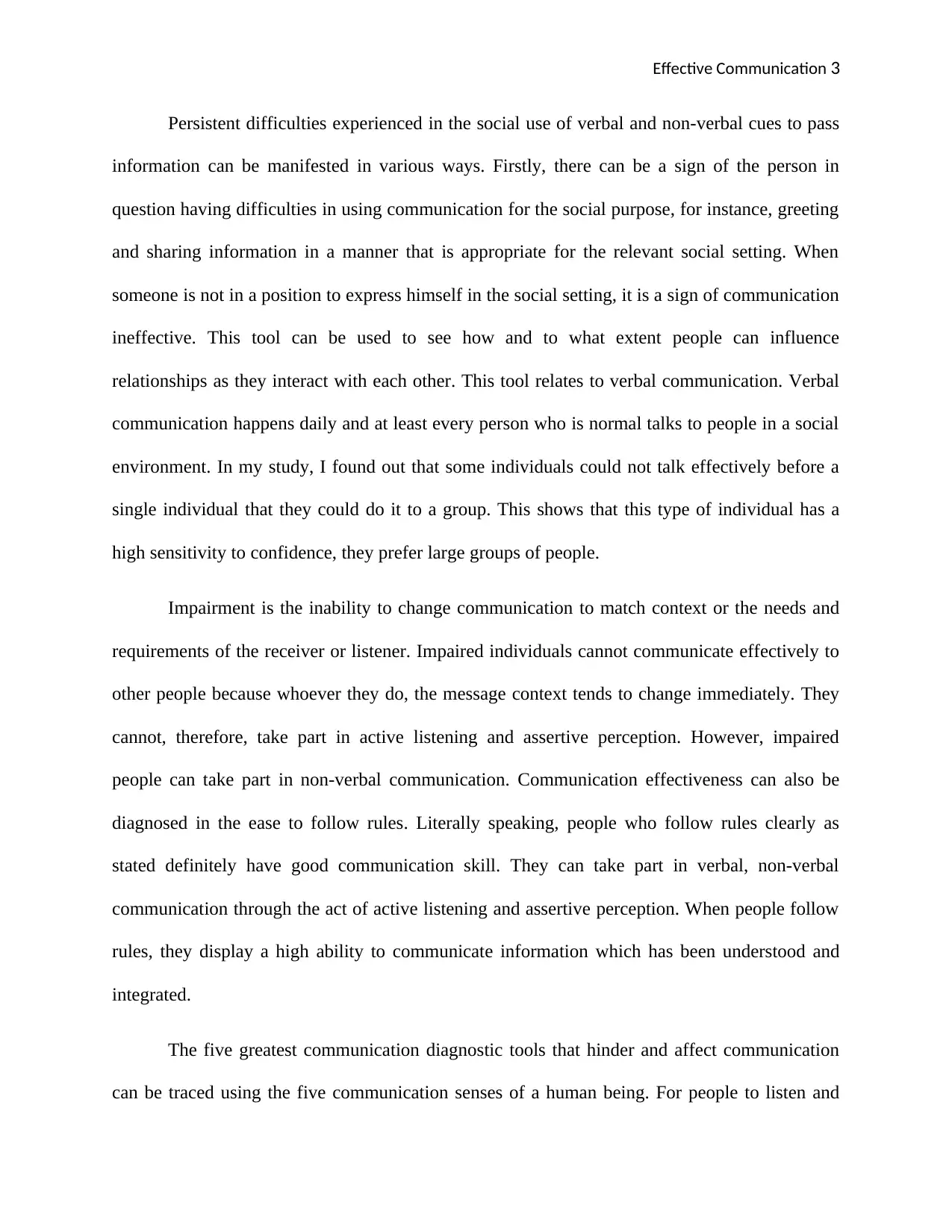
Effective Communication 3
Persistent difficulties experienced in the social use of verbal and non-verbal cues to pass
information can be manifested in various ways. Firstly, there can be a sign of the person in
question having difficulties in using communication for the social purpose, for instance, greeting
and sharing information in a manner that is appropriate for the relevant social setting. When
someone is not in a position to express himself in the social setting, it is a sign of communication
ineffective. This tool can be used to see how and to what extent people can influence
relationships as they interact with each other. This tool relates to verbal communication. Verbal
communication happens daily and at least every person who is normal talks to people in a social
environment. In my study, I found out that some individuals could not talk effectively before a
single individual that they could do it to a group. This shows that this type of individual has a
high sensitivity to confidence, they prefer large groups of people.
Impairment is the inability to change communication to match context or the needs and
requirements of the receiver or listener. Impaired individuals cannot communicate effectively to
other people because whoever they do, the message context tends to change immediately. They
cannot, therefore, take part in active listening and assertive perception. However, impaired
people can take part in non-verbal communication. Communication effectiveness can also be
diagnosed in the ease to follow rules. Literally speaking, people who follow rules clearly as
stated definitely have good communication skill. They can take part in verbal, non-verbal
communication through the act of active listening and assertive perception. When people follow
rules, they display a high ability to communicate information which has been understood and
integrated.
The five greatest communication diagnostic tools that hinder and affect communication
can be traced using the five communication senses of a human being. For people to listen and
Persistent difficulties experienced in the social use of verbal and non-verbal cues to pass
information can be manifested in various ways. Firstly, there can be a sign of the person in
question having difficulties in using communication for the social purpose, for instance, greeting
and sharing information in a manner that is appropriate for the relevant social setting. When
someone is not in a position to express himself in the social setting, it is a sign of communication
ineffective. This tool can be used to see how and to what extent people can influence
relationships as they interact with each other. This tool relates to verbal communication. Verbal
communication happens daily and at least every person who is normal talks to people in a social
environment. In my study, I found out that some individuals could not talk effectively before a
single individual that they could do it to a group. This shows that this type of individual has a
high sensitivity to confidence, they prefer large groups of people.
Impairment is the inability to change communication to match context or the needs and
requirements of the receiver or listener. Impaired individuals cannot communicate effectively to
other people because whoever they do, the message context tends to change immediately. They
cannot, therefore, take part in active listening and assertive perception. However, impaired
people can take part in non-verbal communication. Communication effectiveness can also be
diagnosed in the ease to follow rules. Literally speaking, people who follow rules clearly as
stated definitely have good communication skill. They can take part in verbal, non-verbal
communication through the act of active listening and assertive perception. When people follow
rules, they display a high ability to communicate information which has been understood and
integrated.
The five greatest communication diagnostic tools that hinder and affect communication
can be traced using the five communication senses of a human being. For people to listen and
⊘ This is a preview!⊘
Do you want full access?
Subscribe today to unlock all pages.

Trusted by 1+ million students worldwide
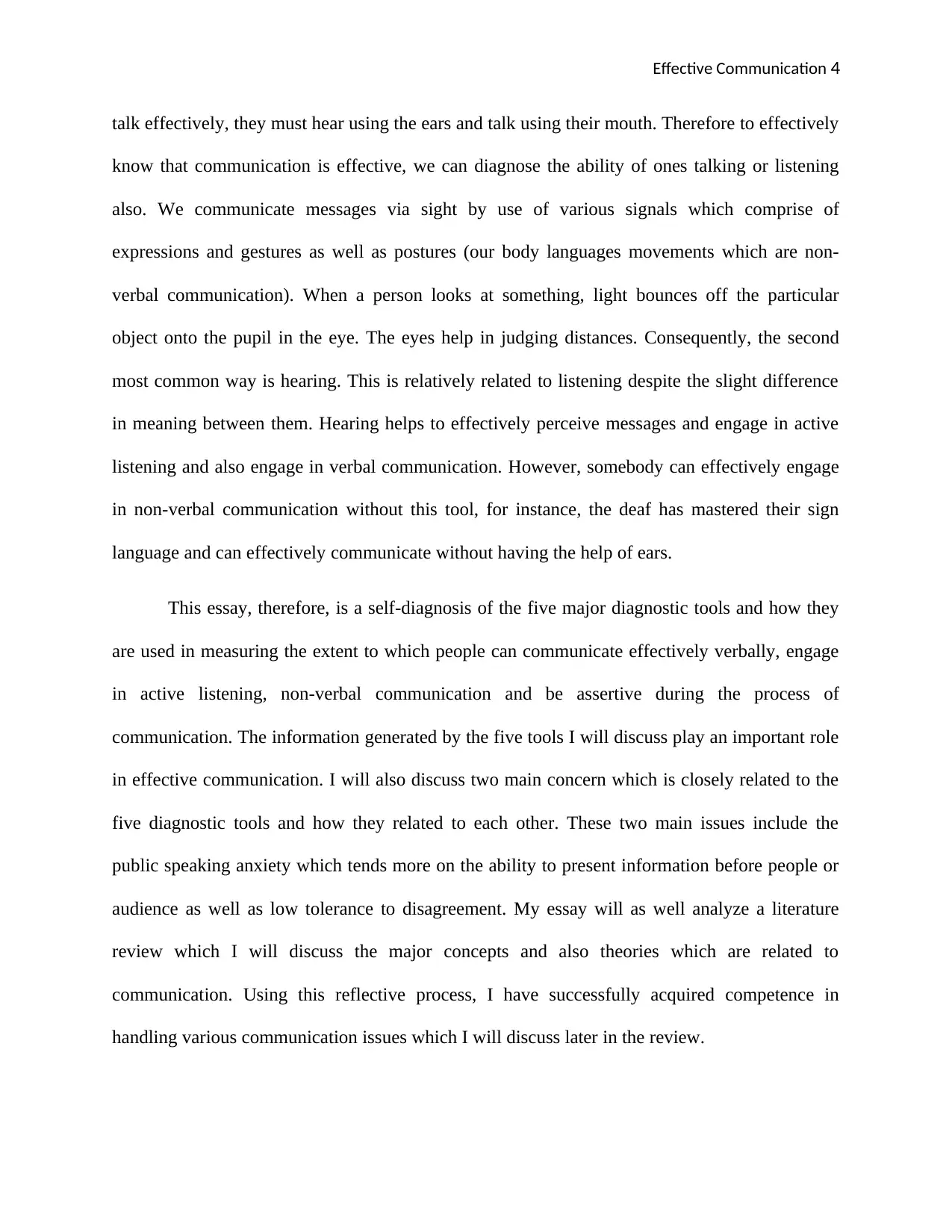
Effective Communication 4
talk effectively, they must hear using the ears and talk using their mouth. Therefore to effectively
know that communication is effective, we can diagnose the ability of ones talking or listening
also. We communicate messages via sight by use of various signals which comprise of
expressions and gestures as well as postures (our body languages movements which are non-
verbal communication). When a person looks at something, light bounces off the particular
object onto the pupil in the eye. The eyes help in judging distances. Consequently, the second
most common way is hearing. This is relatively related to listening despite the slight difference
in meaning between them. Hearing helps to effectively perceive messages and engage in active
listening and also engage in verbal communication. However, somebody can effectively engage
in non-verbal communication without this tool, for instance, the deaf has mastered their sign
language and can effectively communicate without having the help of ears.
This essay, therefore, is a self-diagnosis of the five major diagnostic tools and how they
are used in measuring the extent to which people can communicate effectively verbally, engage
in active listening, non-verbal communication and be assertive during the process of
communication. The information generated by the five tools I will discuss play an important role
in effective communication. I will also discuss two main concern which is closely related to the
five diagnostic tools and how they related to each other. These two main issues include the
public speaking anxiety which tends more on the ability to present information before people or
audience as well as low tolerance to disagreement. My essay will as well analyze a literature
review which I will discuss the major concepts and also theories which are related to
communication. Using this reflective process, I have successfully acquired competence in
handling various communication issues which I will discuss later in the review.
talk effectively, they must hear using the ears and talk using their mouth. Therefore to effectively
know that communication is effective, we can diagnose the ability of ones talking or listening
also. We communicate messages via sight by use of various signals which comprise of
expressions and gestures as well as postures (our body languages movements which are non-
verbal communication). When a person looks at something, light bounces off the particular
object onto the pupil in the eye. The eyes help in judging distances. Consequently, the second
most common way is hearing. This is relatively related to listening despite the slight difference
in meaning between them. Hearing helps to effectively perceive messages and engage in active
listening and also engage in verbal communication. However, somebody can effectively engage
in non-verbal communication without this tool, for instance, the deaf has mastered their sign
language and can effectively communicate without having the help of ears.
This essay, therefore, is a self-diagnosis of the five major diagnostic tools and how they
are used in measuring the extent to which people can communicate effectively verbally, engage
in active listening, non-verbal communication and be assertive during the process of
communication. The information generated by the five tools I will discuss play an important role
in effective communication. I will also discuss two main concern which is closely related to the
five diagnostic tools and how they related to each other. These two main issues include the
public speaking anxiety which tends more on the ability to present information before people or
audience as well as low tolerance to disagreement. My essay will as well analyze a literature
review which I will discuss the major concepts and also theories which are related to
communication. Using this reflective process, I have successfully acquired competence in
handling various communication issues which I will discuss later in the review.
Paraphrase This Document
Need a fresh take? Get an instant paraphrase of this document with our AI Paraphraser
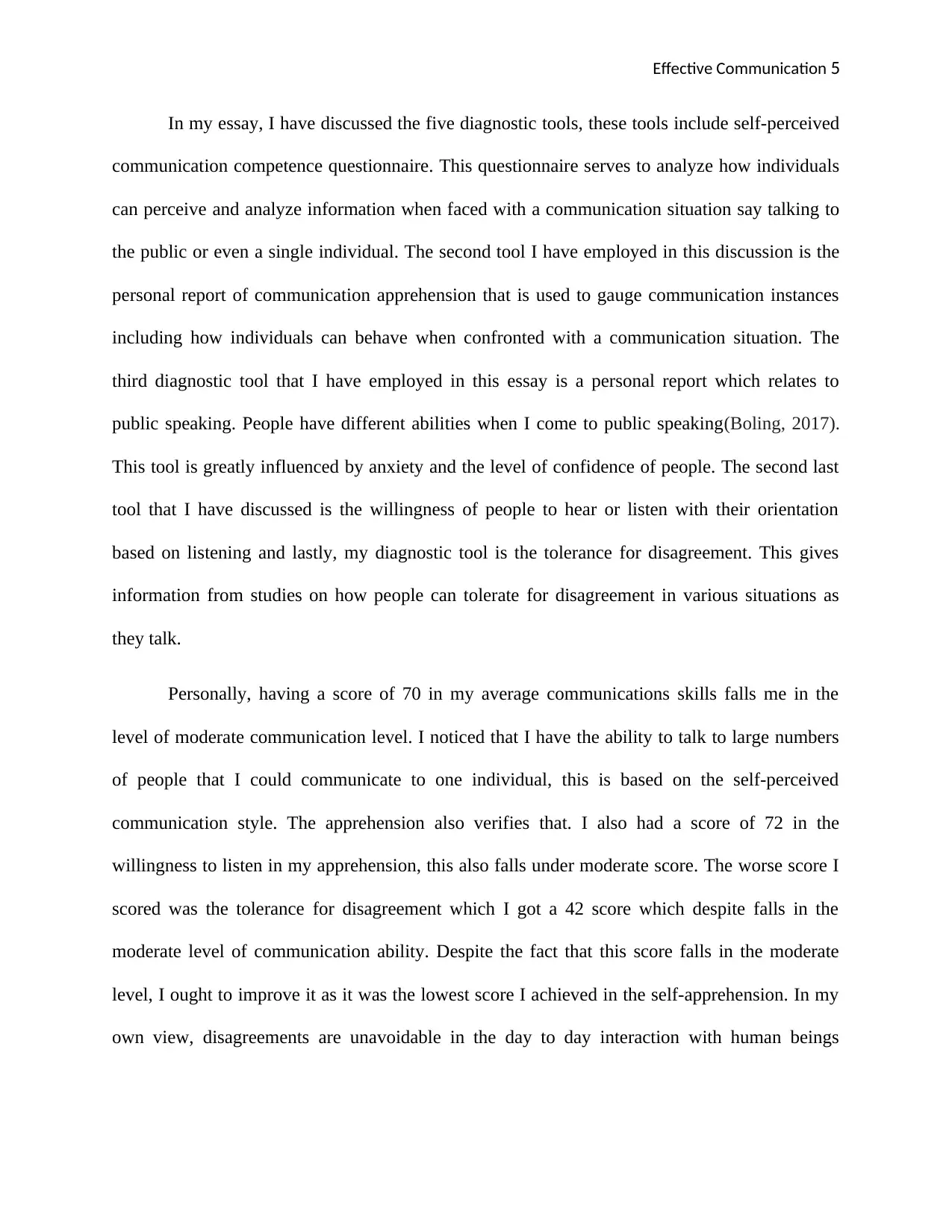
Effective Communication 5
In my essay, I have discussed the five diagnostic tools, these tools include self-perceived
communication competence questionnaire. This questionnaire serves to analyze how individuals
can perceive and analyze information when faced with a communication situation say talking to
the public or even a single individual. The second tool I have employed in this discussion is the
personal report of communication apprehension that is used to gauge communication instances
including how individuals can behave when confronted with a communication situation. The
third diagnostic tool that I have employed in this essay is a personal report which relates to
public speaking. People have different abilities when I come to public speaking(Boling, 2017).
This tool is greatly influenced by anxiety and the level of confidence of people. The second last
tool that I have discussed is the willingness of people to hear or listen with their orientation
based on listening and lastly, my diagnostic tool is the tolerance for disagreement. This gives
information from studies on how people can tolerate for disagreement in various situations as
they talk.
Personally, having a score of 70 in my average communications skills falls me in the
level of moderate communication level. I noticed that I have the ability to talk to large numbers
of people that I could communicate to one individual, this is based on the self-perceived
communication style. The apprehension also verifies that. I also had a score of 72 in the
willingness to listen in my apprehension, this also falls under moderate score. The worse score I
scored was the tolerance for disagreement which I got a 42 score which despite falls in the
moderate level of communication ability. Despite the fact that this score falls in the moderate
level, I ought to improve it as it was the lowest score I achieved in the self-apprehension. In my
own view, disagreements are unavoidable in the day to day interaction with human beings
In my essay, I have discussed the five diagnostic tools, these tools include self-perceived
communication competence questionnaire. This questionnaire serves to analyze how individuals
can perceive and analyze information when faced with a communication situation say talking to
the public or even a single individual. The second tool I have employed in this discussion is the
personal report of communication apprehension that is used to gauge communication instances
including how individuals can behave when confronted with a communication situation. The
third diagnostic tool that I have employed in this essay is a personal report which relates to
public speaking. People have different abilities when I come to public speaking(Boling, 2017).
This tool is greatly influenced by anxiety and the level of confidence of people. The second last
tool that I have discussed is the willingness of people to hear or listen with their orientation
based on listening and lastly, my diagnostic tool is the tolerance for disagreement. This gives
information from studies on how people can tolerate for disagreement in various situations as
they talk.
Personally, having a score of 70 in my average communications skills falls me in the
level of moderate communication level. I noticed that I have the ability to talk to large numbers
of people that I could communicate to one individual, this is based on the self-perceived
communication style. The apprehension also verifies that. I also had a score of 72 in the
willingness to listen in my apprehension, this also falls under moderate score. The worse score I
scored was the tolerance for disagreement which I got a 42 score which despite falls in the
moderate level of communication ability. Despite the fact that this score falls in the moderate
level, I ought to improve it as it was the lowest score I achieved in the self-apprehension. In my
own view, disagreements are unavoidable in the day to day interaction with human beings
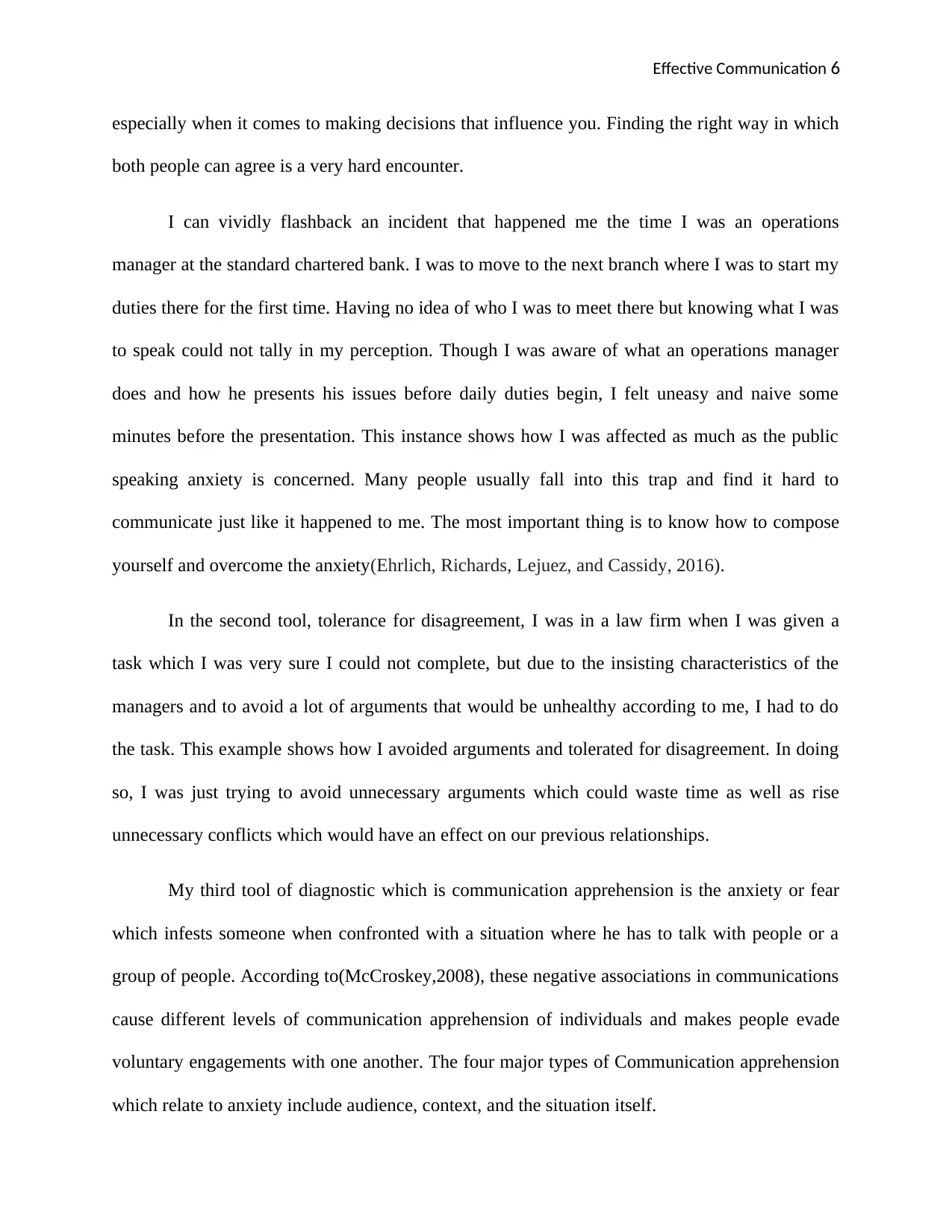
Effective Communication 6
especially when it comes to making decisions that influence you. Finding the right way in which
both people can agree is a very hard encounter.
I can vividly flashback an incident that happened me the time I was an operations
manager at the standard chartered bank. I was to move to the next branch where I was to start my
duties there for the first time. Having no idea of who I was to meet there but knowing what I was
to speak could not tally in my perception. Though I was aware of what an operations manager
does and how he presents his issues before daily duties begin, I felt uneasy and naive some
minutes before the presentation. This instance shows how I was affected as much as the public
speaking anxiety is concerned. Many people usually fall into this trap and find it hard to
communicate just like it happened to me. The most important thing is to know how to compose
yourself and overcome the anxiety(Ehrlich, Richards, Lejuez, and Cassidy, 2016).
In the second tool, tolerance for disagreement, I was in a law firm when I was given a
task which I was very sure I could not complete, but due to the insisting characteristics of the
managers and to avoid a lot of arguments that would be unhealthy according to me, I had to do
the task. This example shows how I avoided arguments and tolerated for disagreement. In doing
so, I was just trying to avoid unnecessary arguments which could waste time as well as rise
unnecessary conflicts which would have an effect on our previous relationships.
My third tool of diagnostic which is communication apprehension is the anxiety or fear
which infests someone when confronted with a situation where he has to talk with people or a
group of people. According to(McCroskey,2008), these negative associations in communications
cause different levels of communication apprehension of individuals and makes people evade
voluntary engagements with one another. The four major types of Communication apprehension
which relate to anxiety include audience, context, and the situation itself.
especially when it comes to making decisions that influence you. Finding the right way in which
both people can agree is a very hard encounter.
I can vividly flashback an incident that happened me the time I was an operations
manager at the standard chartered bank. I was to move to the next branch where I was to start my
duties there for the first time. Having no idea of who I was to meet there but knowing what I was
to speak could not tally in my perception. Though I was aware of what an operations manager
does and how he presents his issues before daily duties begin, I felt uneasy and naive some
minutes before the presentation. This instance shows how I was affected as much as the public
speaking anxiety is concerned. Many people usually fall into this trap and find it hard to
communicate just like it happened to me. The most important thing is to know how to compose
yourself and overcome the anxiety(Ehrlich, Richards, Lejuez, and Cassidy, 2016).
In the second tool, tolerance for disagreement, I was in a law firm when I was given a
task which I was very sure I could not complete, but due to the insisting characteristics of the
managers and to avoid a lot of arguments that would be unhealthy according to me, I had to do
the task. This example shows how I avoided arguments and tolerated for disagreement. In doing
so, I was just trying to avoid unnecessary arguments which could waste time as well as rise
unnecessary conflicts which would have an effect on our previous relationships.
My third tool of diagnostic which is communication apprehension is the anxiety or fear
which infests someone when confronted with a situation where he has to talk with people or a
group of people. According to(McCroskey,2008), these negative associations in communications
cause different levels of communication apprehension of individuals and makes people evade
voluntary engagements with one another. The four major types of Communication apprehension
which relate to anxiety include audience, context, and the situation itself.
⊘ This is a preview!⊘
Do you want full access?
Subscribe today to unlock all pages.

Trusted by 1+ million students worldwide
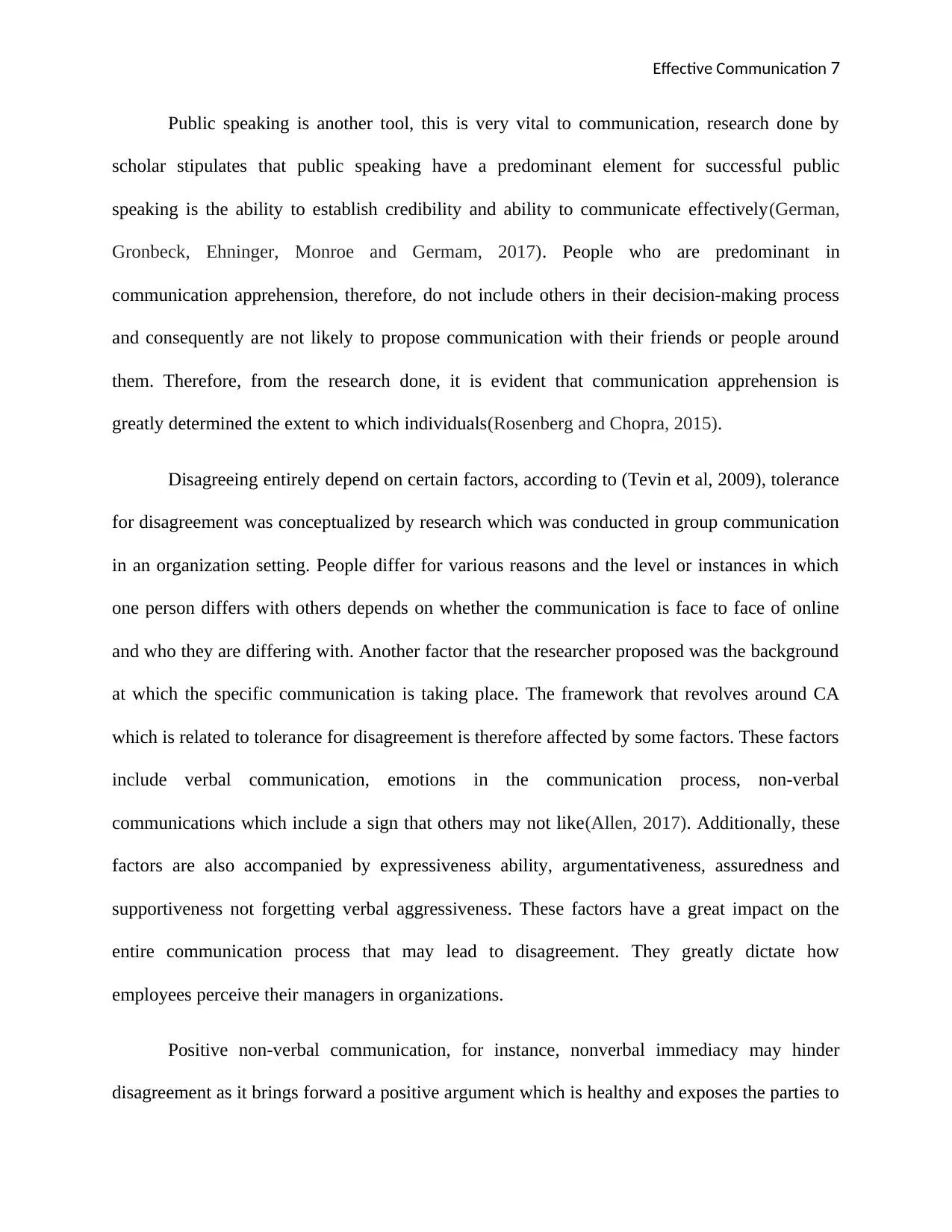
Effective Communication 7
Public speaking is another tool, this is very vital to communication, research done by
scholar stipulates that public speaking have a predominant element for successful public
speaking is the ability to establish credibility and ability to communicate effectively(German,
Gronbeck, Ehninger, Monroe and Germam, 2017). People who are predominant in
communication apprehension, therefore, do not include others in their decision-making process
and consequently are not likely to propose communication with their friends or people around
them. Therefore, from the research done, it is evident that communication apprehension is
greatly determined the extent to which individuals(Rosenberg and Chopra, 2015).
Disagreeing entirely depend on certain factors, according to (Tevin et al, 2009), tolerance
for disagreement was conceptualized by research which was conducted in group communication
in an organization setting. People differ for various reasons and the level or instances in which
one person differs with others depends on whether the communication is face to face of online
and who they are differing with. Another factor that the researcher proposed was the background
at which the specific communication is taking place. The framework that revolves around CA
which is related to tolerance for disagreement is therefore affected by some factors. These factors
include verbal communication, emotions in the communication process, non-verbal
communications which include a sign that others may not like(Allen, 2017). Additionally, these
factors are also accompanied by expressiveness ability, argumentativeness, assuredness and
supportiveness not forgetting verbal aggressiveness. These factors have a great impact on the
entire communication process that may lead to disagreement. They greatly dictate how
employees perceive their managers in organizations.
Positive non-verbal communication, for instance, nonverbal immediacy may hinder
disagreement as it brings forward a positive argument which is healthy and exposes the parties to
Public speaking is another tool, this is very vital to communication, research done by
scholar stipulates that public speaking have a predominant element for successful public
speaking is the ability to establish credibility and ability to communicate effectively(German,
Gronbeck, Ehninger, Monroe and Germam, 2017). People who are predominant in
communication apprehension, therefore, do not include others in their decision-making process
and consequently are not likely to propose communication with their friends or people around
them. Therefore, from the research done, it is evident that communication apprehension is
greatly determined the extent to which individuals(Rosenberg and Chopra, 2015).
Disagreeing entirely depend on certain factors, according to (Tevin et al, 2009), tolerance
for disagreement was conceptualized by research which was conducted in group communication
in an organization setting. People differ for various reasons and the level or instances in which
one person differs with others depends on whether the communication is face to face of online
and who they are differing with. Another factor that the researcher proposed was the background
at which the specific communication is taking place. The framework that revolves around CA
which is related to tolerance for disagreement is therefore affected by some factors. These factors
include verbal communication, emotions in the communication process, non-verbal
communications which include a sign that others may not like(Allen, 2017). Additionally, these
factors are also accompanied by expressiveness ability, argumentativeness, assuredness and
supportiveness not forgetting verbal aggressiveness. These factors have a great impact on the
entire communication process that may lead to disagreement. They greatly dictate how
employees perceive their managers in organizations.
Positive non-verbal communication, for instance, nonverbal immediacy may hinder
disagreement as it brings forward a positive argument which is healthy and exposes the parties to
Paraphrase This Document
Need a fresh take? Get an instant paraphrase of this document with our AI Paraphraser
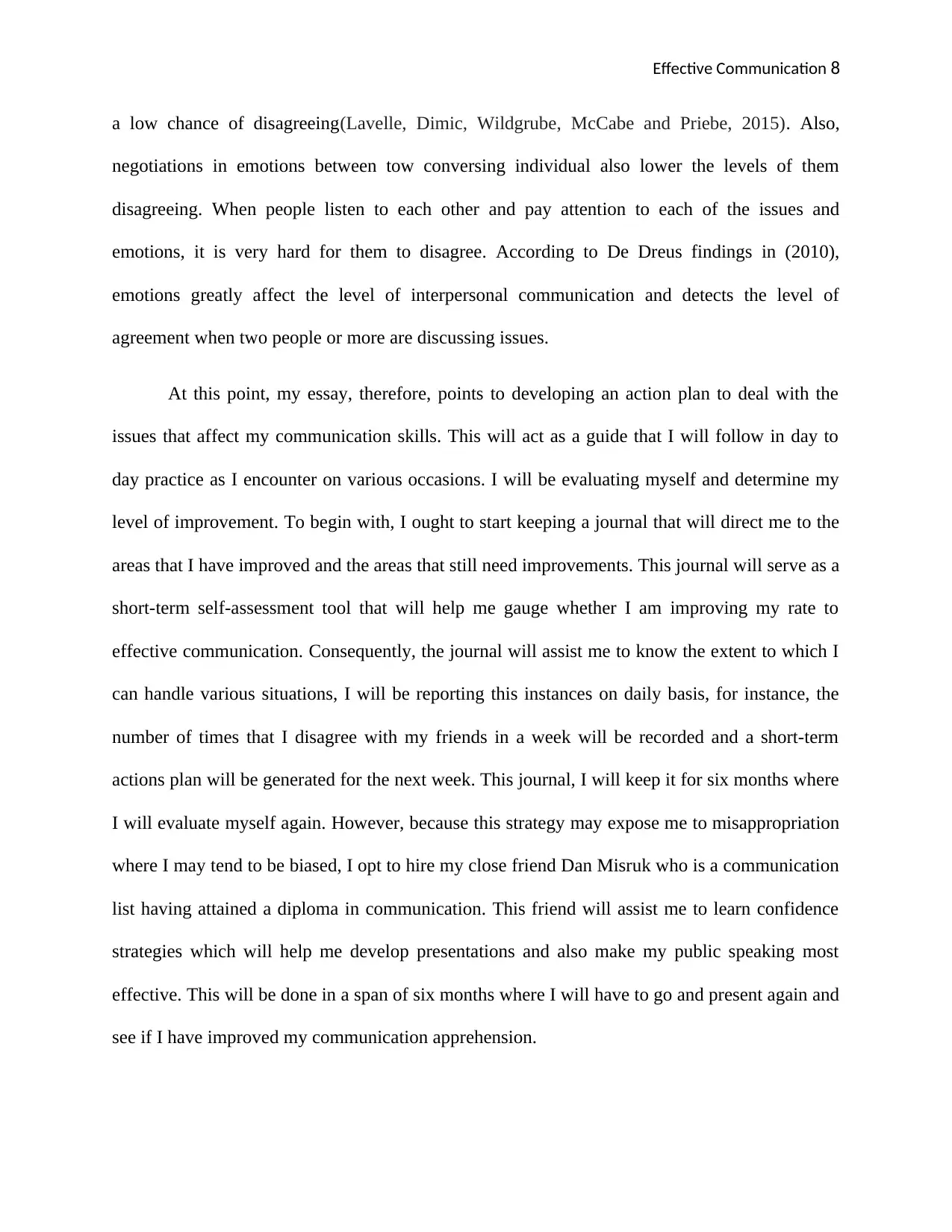
Effective Communication 8
a low chance of disagreeing(Lavelle, Dimic, Wildgrube, McCabe and Priebe, 2015). Also,
negotiations in emotions between tow conversing individual also lower the levels of them
disagreeing. When people listen to each other and pay attention to each of the issues and
emotions, it is very hard for them to disagree. According to De Dreus findings in (2010),
emotions greatly affect the level of interpersonal communication and detects the level of
agreement when two people or more are discussing issues.
At this point, my essay, therefore, points to developing an action plan to deal with the
issues that affect my communication skills. This will act as a guide that I will follow in day to
day practice as I encounter on various occasions. I will be evaluating myself and determine my
level of improvement. To begin with, I ought to start keeping a journal that will direct me to the
areas that I have improved and the areas that still need improvements. This journal will serve as a
short-term self-assessment tool that will help me gauge whether I am improving my rate to
effective communication. Consequently, the journal will assist me to know the extent to which I
can handle various situations, I will be reporting this instances on daily basis, for instance, the
number of times that I disagree with my friends in a week will be recorded and a short-term
actions plan will be generated for the next week. This journal, I will keep it for six months where
I will evaluate myself again. However, because this strategy may expose me to misappropriation
where I may tend to be biased, I opt to hire my close friend Dan Misruk who is a communication
list having attained a diploma in communication. This friend will assist me to learn confidence
strategies which will help me develop presentations and also make my public speaking most
effective. This will be done in a span of six months where I will have to go and present again and
see if I have improved my communication apprehension.
a low chance of disagreeing(Lavelle, Dimic, Wildgrube, McCabe and Priebe, 2015). Also,
negotiations in emotions between tow conversing individual also lower the levels of them
disagreeing. When people listen to each other and pay attention to each of the issues and
emotions, it is very hard for them to disagree. According to De Dreus findings in (2010),
emotions greatly affect the level of interpersonal communication and detects the level of
agreement when two people or more are discussing issues.
At this point, my essay, therefore, points to developing an action plan to deal with the
issues that affect my communication skills. This will act as a guide that I will follow in day to
day practice as I encounter on various occasions. I will be evaluating myself and determine my
level of improvement. To begin with, I ought to start keeping a journal that will direct me to the
areas that I have improved and the areas that still need improvements. This journal will serve as a
short-term self-assessment tool that will help me gauge whether I am improving my rate to
effective communication. Consequently, the journal will assist me to know the extent to which I
can handle various situations, I will be reporting this instances on daily basis, for instance, the
number of times that I disagree with my friends in a week will be recorded and a short-term
actions plan will be generated for the next week. This journal, I will keep it for six months where
I will evaluate myself again. However, because this strategy may expose me to misappropriation
where I may tend to be biased, I opt to hire my close friend Dan Misruk who is a communication
list having attained a diploma in communication. This friend will assist me to learn confidence
strategies which will help me develop presentations and also make my public speaking most
effective. This will be done in a span of six months where I will have to go and present again and
see if I have improved my communication apprehension.

Effective Communication 9
I will also practice apprehension avoidance techniques, these will include mental
practices which have been of late used by many athletes in their performance(Bowman, 2018). I
will also take deep breathes whenever I encounter a presentation and realize I am anxious, these
breathe reduces the anxiety and makes one who is to deliver a talk be composed. By employing
this strategy, therefore, I hope to avoid anxiety at the present time. To complicate this also, I
have chosen some important books which relate to improving communication skills and
communication apprehension. These books include Effectiveness" by Richmond, Wrench, and
McCroskey (Amazon.com, 2017a), "Umm. .: A Complete Guide to Public Speaking" by
O'Loghlin (Cengage Learning, 2017) and “Managing Interpersonal Conflict (Interpersonal
Communication Texts)” by Donohue (Amazon.com, 2017).
I will as well attend various training seminars and meetings that will acquit me with
knowledge, skills, and attitude to develop my communication skills. This will be a great move
because I will also get certificates from this seminars and meetings. I ought to take the frontline
in participation by answering questions and reacting to issues. According to (Zhang et al, 2017)
in the book on Effective people and communication skills, for one to improve communication,
one must take part actively in learning communication strategies which are conducted in this
seminars.
Besides all these plans, I will also practice in self-evaluation. I will be training myself
whenever I am alone in my room. I will buy a new mirror which will help me be my audience. I
will be talking to myself in the mirror so that I can gain confidence. In this actions, I will be
behaving like presenting the speech to a crown or individual. Also, I will have video recordings
and audios and listen to them when I am free so that I can correct mistakes that I have made.
This will help me improve my skills and confidence. In this practice, I will exercise body
I will also practice apprehension avoidance techniques, these will include mental
practices which have been of late used by many athletes in their performance(Bowman, 2018). I
will also take deep breathes whenever I encounter a presentation and realize I am anxious, these
breathe reduces the anxiety and makes one who is to deliver a talk be composed. By employing
this strategy, therefore, I hope to avoid anxiety at the present time. To complicate this also, I
have chosen some important books which relate to improving communication skills and
communication apprehension. These books include Effectiveness" by Richmond, Wrench, and
McCroskey (Amazon.com, 2017a), "Umm. .: A Complete Guide to Public Speaking" by
O'Loghlin (Cengage Learning, 2017) and “Managing Interpersonal Conflict (Interpersonal
Communication Texts)” by Donohue (Amazon.com, 2017).
I will as well attend various training seminars and meetings that will acquit me with
knowledge, skills, and attitude to develop my communication skills. This will be a great move
because I will also get certificates from this seminars and meetings. I ought to take the frontline
in participation by answering questions and reacting to issues. According to (Zhang et al, 2017)
in the book on Effective people and communication skills, for one to improve communication,
one must take part actively in learning communication strategies which are conducted in this
seminars.
Besides all these plans, I will also practice in self-evaluation. I will be training myself
whenever I am alone in my room. I will buy a new mirror which will help me be my audience. I
will be talking to myself in the mirror so that I can gain confidence. In this actions, I will be
behaving like presenting the speech to a crown or individual. Also, I will have video recordings
and audios and listen to them when I am free so that I can correct mistakes that I have made.
This will help me improve my skills and confidence. In this practice, I will exercise body
⊘ This is a preview!⊘
Do you want full access?
Subscribe today to unlock all pages.

Trusted by 1+ million students worldwide

Effective Communication 10
language during my presentations. This will include the use of gestures, blank face, smiling to
the audience in some instances, tilting the head back or even nodding while I am presenting.
In conclusion, therefore, Communication is very important in day to day activities.
Without effective communication, communication does not have any meaning. For people to
understand each other, they must always know how to communicate effectively(Thompson,
2018). Effective communication comprises using the various skills that relate to communication
to relay your message. Different people can communicate differently and have different qualities
as much as communication is concerned(Mukherji, Jain, and Sharma, 2016). There are those
people who cannot talk to a large group of people, others cannot talk to individuals while others
cannot talk to neither groups nor individuals. This traits however can be overcome by practicing
the skills for effective communication. Diagnostic tools in this essay are very relevant and can be
used to evaluate ones level of communication. Communication might be effective only if the
right measures are put into consideration as we saw in this essay in our simple communication
model. In this essay, I gave an insight to five major diagnostic tools which are used in gathering
information of the communication issues that I presented. I also discussed the two key concern
which included the tolerance for disagreement and public speaking. I have devised ways on how
I will improve the skills for future preparedness. We can improve communication by attending
various teaching seminars and hiring communication specialist to train us(Kurtz, Draper and
Silverman, 2016).
language during my presentations. This will include the use of gestures, blank face, smiling to
the audience in some instances, tilting the head back or even nodding while I am presenting.
In conclusion, therefore, Communication is very important in day to day activities.
Without effective communication, communication does not have any meaning. For people to
understand each other, they must always know how to communicate effectively(Thompson,
2018). Effective communication comprises using the various skills that relate to communication
to relay your message. Different people can communicate differently and have different qualities
as much as communication is concerned(Mukherji, Jain, and Sharma, 2016). There are those
people who cannot talk to a large group of people, others cannot talk to individuals while others
cannot talk to neither groups nor individuals. This traits however can be overcome by practicing
the skills for effective communication. Diagnostic tools in this essay are very relevant and can be
used to evaluate ones level of communication. Communication might be effective only if the
right measures are put into consideration as we saw in this essay in our simple communication
model. In this essay, I gave an insight to five major diagnostic tools which are used in gathering
information of the communication issues that I presented. I also discussed the two key concern
which included the tolerance for disagreement and public speaking. I have devised ways on how
I will improve the skills for future preparedness. We can improve communication by attending
various teaching seminars and hiring communication specialist to train us(Kurtz, Draper and
Silverman, 2016).
Paraphrase This Document
Need a fresh take? Get an instant paraphrase of this document with our AI Paraphraser
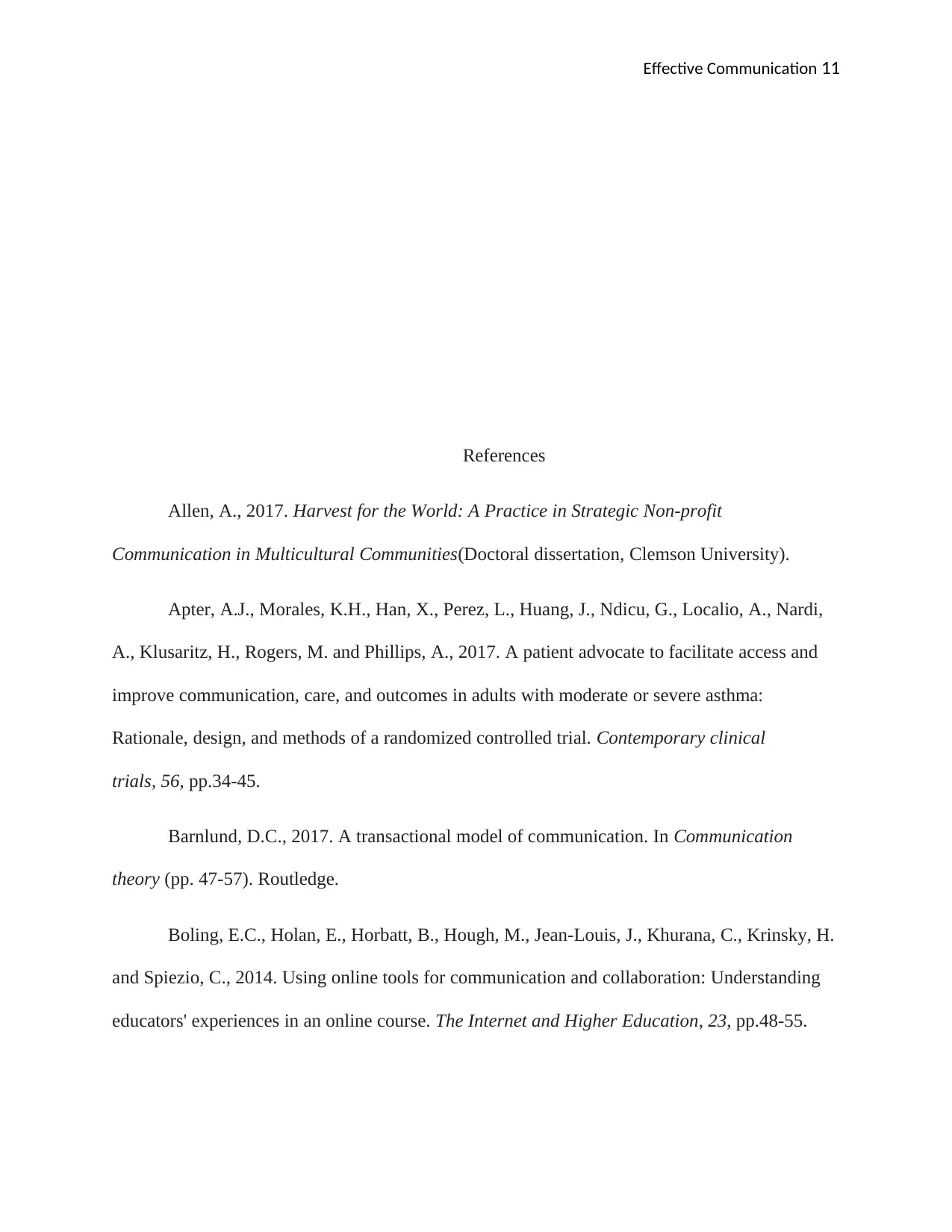
Effective Communication 11
References
Allen, A., 2017. Harvest for the World: A Practice in Strategic Non-profit
Communication in Multicultural Communities(Doctoral dissertation, Clemson University).
Apter, A.J., Morales, K.H., Han, X., Perez, L., Huang, J., Ndicu, G., Localio, A., Nardi,
A., Klusaritz, H., Rogers, M. and Phillips, A., 2017. A patient advocate to facilitate access and
improve communication, care, and outcomes in adults with moderate or severe asthma:
Rationale, design, and methods of a randomized controlled trial. Contemporary clinical
trials, 56, pp.34-45.
Barnlund, D.C., 2017. A transactional model of communication. In Communication
theory (pp. 47-57). Routledge.
Boling, E.C., Holan, E., Horbatt, B., Hough, M., Jean-Louis, J., Khurana, C., Krinsky, H.
and Spiezio, C., 2014. Using online tools for communication and collaboration: Understanding
educators' experiences in an online course. The Internet and Higher Education, 23, pp.48-55.
References
Allen, A., 2017. Harvest for the World: A Practice in Strategic Non-profit
Communication in Multicultural Communities(Doctoral dissertation, Clemson University).
Apter, A.J., Morales, K.H., Han, X., Perez, L., Huang, J., Ndicu, G., Localio, A., Nardi,
A., Klusaritz, H., Rogers, M. and Phillips, A., 2017. A patient advocate to facilitate access and
improve communication, care, and outcomes in adults with moderate or severe asthma:
Rationale, design, and methods of a randomized controlled trial. Contemporary clinical
trials, 56, pp.34-45.
Barnlund, D.C., 2017. A transactional model of communication. In Communication
theory (pp. 47-57). Routledge.
Boling, E.C., Holan, E., Horbatt, B., Hough, M., Jean-Louis, J., Khurana, C., Krinsky, H.
and Spiezio, C., 2014. Using online tools for communication and collaboration: Understanding
educators' experiences in an online course. The Internet and Higher Education, 23, pp.48-55.
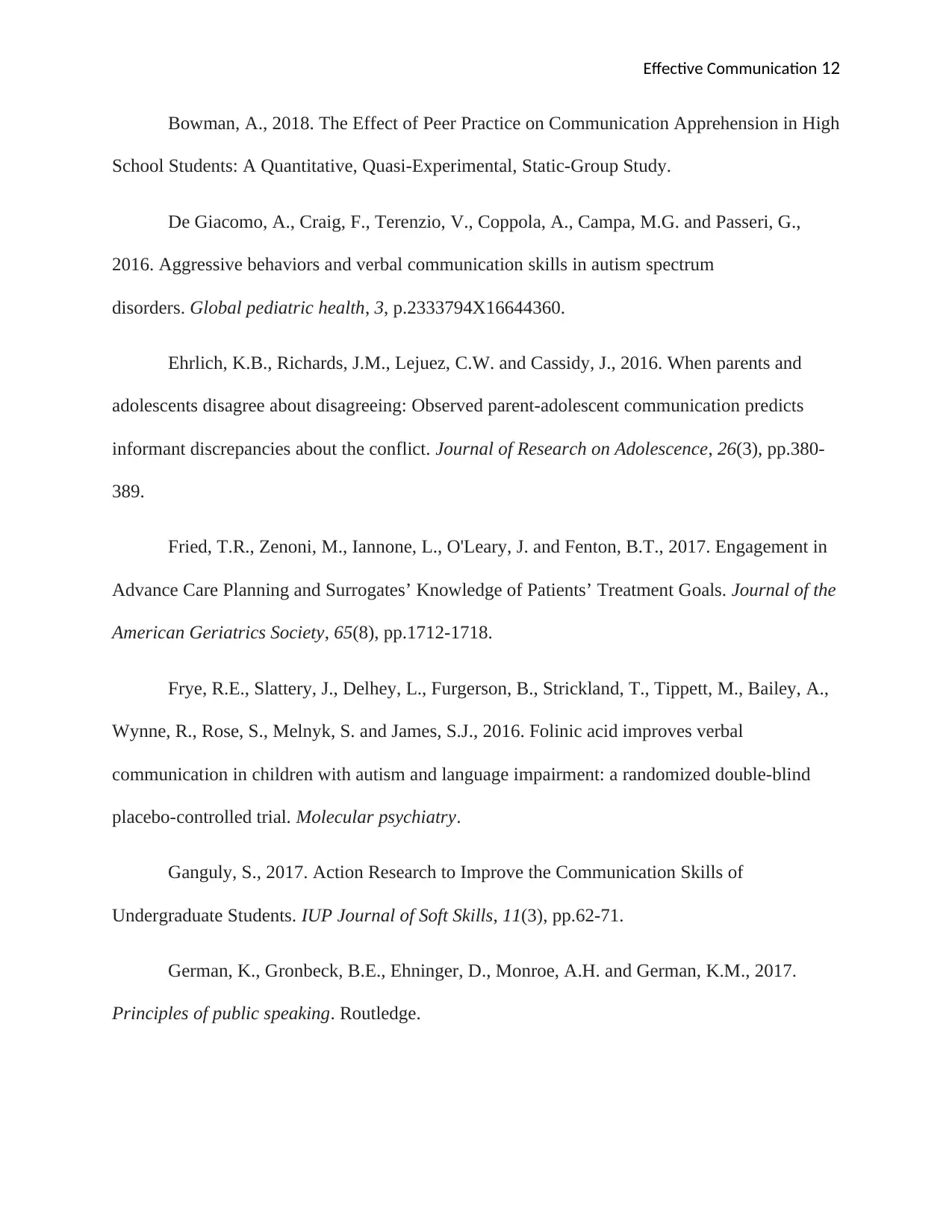
Effective Communication 12
Bowman, A., 2018. The Effect of Peer Practice on Communication Apprehension in High
School Students: A Quantitative, Quasi-Experimental, Static-Group Study.
De Giacomo, A., Craig, F., Terenzio, V., Coppola, A., Campa, M.G. and Passeri, G.,
2016. Aggressive behaviors and verbal communication skills in autism spectrum
disorders. Global pediatric health, 3, p.2333794X16644360.
Ehrlich, K.B., Richards, J.M., Lejuez, C.W. and Cassidy, J., 2016. When parents and
adolescents disagree about disagreeing: Observed parent-adolescent communication predicts
informant discrepancies about the conflict. Journal of Research on Adolescence, 26(3), pp.380-
389.
Fried, T.R., Zenoni, M., Iannone, L., O'Leary, J. and Fenton, B.T., 2017. Engagement in
Advance Care Planning and Surrogates’ Knowledge of Patients’ Treatment Goals. Journal of the
American Geriatrics Society, 65(8), pp.1712-1718.
Frye, R.E., Slattery, J., Delhey, L., Furgerson, B., Strickland, T., Tippett, M., Bailey, A.,
Wynne, R., Rose, S., Melnyk, S. and James, S.J., 2016. Folinic acid improves verbal
communication in children with autism and language impairment: a randomized double-blind
placebo-controlled trial. Molecular psychiatry.
Ganguly, S., 2017. Action Research to Improve the Communication Skills of
Undergraduate Students. IUP Journal of Soft Skills, 11(3), pp.62-71.
German, K., Gronbeck, B.E., Ehninger, D., Monroe, A.H. and German, K.M., 2017.
Principles of public speaking. Routledge.
Bowman, A., 2018. The Effect of Peer Practice on Communication Apprehension in High
School Students: A Quantitative, Quasi-Experimental, Static-Group Study.
De Giacomo, A., Craig, F., Terenzio, V., Coppola, A., Campa, M.G. and Passeri, G.,
2016. Aggressive behaviors and verbal communication skills in autism spectrum
disorders. Global pediatric health, 3, p.2333794X16644360.
Ehrlich, K.B., Richards, J.M., Lejuez, C.W. and Cassidy, J., 2016. When parents and
adolescents disagree about disagreeing: Observed parent-adolescent communication predicts
informant discrepancies about the conflict. Journal of Research on Adolescence, 26(3), pp.380-
389.
Fried, T.R., Zenoni, M., Iannone, L., O'Leary, J. and Fenton, B.T., 2017. Engagement in
Advance Care Planning and Surrogates’ Knowledge of Patients’ Treatment Goals. Journal of the
American Geriatrics Society, 65(8), pp.1712-1718.
Frye, R.E., Slattery, J., Delhey, L., Furgerson, B., Strickland, T., Tippett, M., Bailey, A.,
Wynne, R., Rose, S., Melnyk, S. and James, S.J., 2016. Folinic acid improves verbal
communication in children with autism and language impairment: a randomized double-blind
placebo-controlled trial. Molecular psychiatry.
Ganguly, S., 2017. Action Research to Improve the Communication Skills of
Undergraduate Students. IUP Journal of Soft Skills, 11(3), pp.62-71.
German, K., Gronbeck, B.E., Ehninger, D., Monroe, A.H. and German, K.M., 2017.
Principles of public speaking. Routledge.
⊘ This is a preview!⊘
Do you want full access?
Subscribe today to unlock all pages.

Trusted by 1+ million students worldwide
1 out of 15
Related Documents
Your All-in-One AI-Powered Toolkit for Academic Success.
+13062052269
info@desklib.com
Available 24*7 on WhatsApp / Email
![[object Object]](/_next/static/media/star-bottom.7253800d.svg)
Unlock your academic potential
Copyright © 2020–2025 A2Z Services. All Rights Reserved. Developed and managed by ZUCOL.





